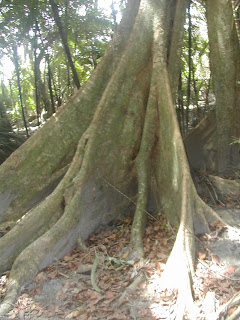Here at La Gringa's Blogicito, no expense is spared to show you a good time. La Gringa's roving reporter El Jefe had an opportunity to go to Punta Sal in the Jeanette Kawas National Park so he took some photographs just for you.
Here is some background information from the Honduras Moon Handbook:
Parque Nacional Jeanette Kawas (Punta Sal)The park is named after environmentalist Jeanette Kawas who became a strong advocate for the environment after returning to Honduras after living many years in the U.S. She, a U.S. Peace Corp volunteer, and citizens of Tela started a group called Prolansate in 1990. In November 1994, they succeeded in having the Punta Sal area designated as a protected national park.
One of the most biologically diverse natural reserves in Honduras, the 782 square kilometers of protected territory around Punta Sal includes humid tropical forest, mangrove swamp, coastal lagoons, rivers and canals, rocky and sandy coastline, coral reef, and ocean. Almost 500 types of plants have been identified with the park, as well as 232 animal species, including endangered marine turtles, manatees, jaguars, ocelots (tigrillos), caymans, white-faced and howler monkeys, wild pigs, pelicans, and toucans.
She personally, along with Prolansate, patrolled the park looking for poachers. Among the people caught and fined for environmental violations were cattle ranchers, former military officials, and even a former congressman turned resort owner who was fined $1,000 for illegally catching dolphins.
In early 1995, Prolansate was involved in a major battle with the national farmers organization, who had been granted rights to clear a huge portion of the park for agricultural use, and Hondupalma, a palm oil company who had secured a concession to clear part of the park to grow African oil palm trees.
On February 4, 1995, Señora Kawas, carrying a sign saying "Don't prostitute the park decree!," led a 200-person march protesting these actions which would destroy the park. Two days later, an assassin shot through an open window of her home and killed her as she sat at her kitchen table. Her murder has never been solved.
The two projects mentioned above were stopped and the park was renamed in her honor. Her death along with the deaths of three other environmental activists succeeded in bringing international attention to ecological issues in Honduras for a time. Prolansate continues to operate today.



 Welcome to my Blogicito —
Welcome to my Blogicito — 







